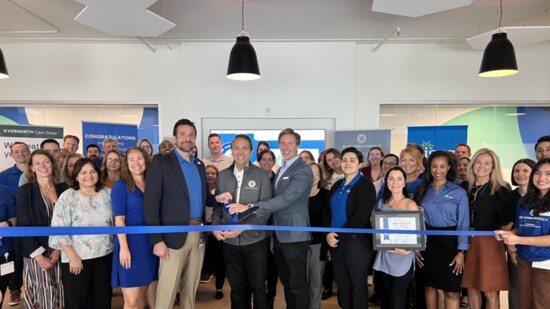Twenty years ago, a new term was coined: blue zone. First mentioned in an academic journal in 2004 to describe an island in Italy where people had exceptional longevity, the concept became part of the popular lexicon the following year when National Geographic reporter Dan Buettner used it in an article highlighting regions around the world where people lived longer and healthier lives than average.
According to Buettner, the blue zones illustrate that good health comes not from pursuing diet and exercise but instead from being in “the right environment.”
Since publishing his article, Buettner has written numerous books on the subject, produced a TV documentary series about blue zones, and developed the Blue Zones Project, a community-led initiative that works to improve well-being in places where people live, work, learn, and play.
The project began in 2009 in Albert Lea, Minnesota. In 2022, Scottsdale became the 78th city in the U.S. and the first in Arizona to join Blue Zones. After almost two years of assessments, research, and planning, Blue Zones Project Scottsdale launched publicly in January 2024.
9 Key Principles
So, what makes a city, a community, or even an individual business a blue zone? During his research, Buettner identified nine common characteristics and behaviors that people in each original blue zone demonstrated. He called these the “Power 9” lifestyle principles.
They’re grouped into four categories.
1. Move. Moving naturally throughout the day is a core component of the Blue Zones lifestyle.
2. Right Outlook: Having a sense of purpose makes you happier and healthier, while taking time to downshift ensures periods of calm.
3. Eat Wisely. Healthier eating habits provide sustainable results. These habits include eating less at meals, eating a predominantly plant-slant diet, and regularly consuming a glass of wine.
4. Connect. Surround yourself with the right people—those who make you happy and support healthy behaviors. Family connections, being part of a faith-based community, and strong social networks are important for a long life.
“What we’re learning with Blue Zones Project is that when we take and incorporate these things to provide additional choices for people, being healthier becomes easier,” explains Sarah Kearney, executive director of Blue Zones Project Scottsdale. “It’s really customizing all of these options, being able to provide additional resources, convening people together, removing barriers, and helping amplify the great work that’s already happening in the community.
“It’s important to note that Blue Zones doesn’t just go into every community,” she adds. “Blue Zones goes into communities that are ready. And Scottsdale has always been known as a healthy community and has been recognized as one that prioritizes well-being.”
Healthy Scottsdale
Since the implementation of Blue Zones Project Scottsdale, several local businesses have earned Blue Zones Project Approved designation.
Some, such as the d’Lite Healthy On The Go chain of restaurants, have multiple locations included in the designation. Others, like Echo Canyon School, are singular operations. And just a few months ago, Hotel Valley Ho became Arizona’s first hotel to be named an approved worksite, while signature restaurant ZuZu also achieved Blue Zones approval.
Village Health Clubs & Spas was recognized as a Blue Zones worksite in June.
“We had heard several presentations [about the Blue Zones Project], and the more we learned about what its goals are for Scottsdale, it aligns exactly with our mission for both our employees and our members,” says Meredith DeAngelis, the club’s chief marketing officer. “It’s not just about fitness for us. It’s not just about running on a treadmill. It's about leading a healthy lifestyle all-around. It’s about building a community.”
Currently, 11 local companies in three sectors—restaurants, schools, and worksites—are Blue Zones locales. Additional sectors include grocery stores, civic-based groups, and faith-based groups.
Kearney anticipates the number of approved businesses to quickly increase, pointing out that a lot are in the approval process pipeline.
“The length of time it takes to become Blue Zones Approved is different for every single organization,” she says. “We want to make sure that the things an organization says it’s doing are actually being done. And then we work with them to create a sustainability plan.”
Individuals can also participate. This past summer, Blue Zones Project sponsored a Walking Moai at Scottsdale Fashion Square. The term “moai” comes from Okinawa, Japan, one of the original blue zones, and means coming together for a common purpose.
“In America, we’re in a social isolation and loneliness epidemic, and it’s impacting not only our aging population but our youth as well,” Kearney says. “This program encouraged people who maybe were feeling lonely or weren’t being as active as they used to be to get out and meet new people and walk together.”
More than 100 people took part in the weekly moais, and Kearney says that Blue Zones Project will be expanding the program into 2025.
As Blue Zones Project Scottsdale shows, creating a culture of health requires dozens of small steps and initiatives by businesses as well as individuals.
“What’s most important is we’re meeting people where they’re at; we’re meeting organizations where they’re at,” Kearney points out. “We’re certainly not pushing anything or making anybody do anything, but it certainly helps when you feel supported. And now there’s a community of people who are right alongside you and wanting to support each other to reach those goals. And that’s fantastic.”
BlueZonesProjectScottsdale.com
“It’s important to note that Blue Zones doesn’t just go into every community. Blue Zones goes into communities that are ready."
“We had heard several presentations [about the Blue Zones Project], and the more we learned about what its goals are for Scottsdale, it aligns exactly with our mission for both our employees and our members.”
